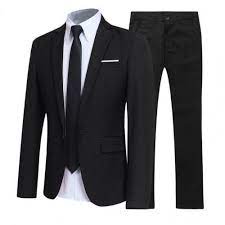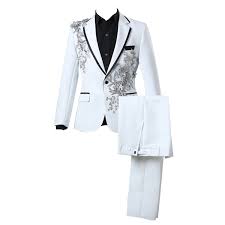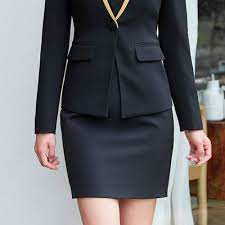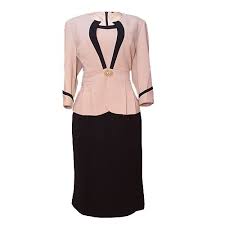Unveiling the Elegance: A Comprehensive Guide to Dress Suits.
A dress suit, commonly known as a suit, is a coordinated ensemble worn for formal or semi-formal occasions. It typically includes a jacket and trousers for men or a jacket and skirt or trousers for women. The term "suit" reflects the coordinated nature of the outfit, with components like a shirt, tie, and accessories complementing each other. Suits are worn for business, special events, or occasions requiring a polished appearance, and they are a versatile and timeless symbol of sartorial refinement. Both men and women can wear suits, embracing a range of styles to suit different preferences and occasions.
Exploring the Classic Appeal of Dress Suits.

In the realm of men's fashion, few garments exude timeless elegance and sophistication quite like the dress suit. Whether worn for business, formal occasions, or a special event, the dress suit stands as a symbol of sartorial refinement. This article delves into the intricacies of the dress suit, exploring its history, components, style variations, and the subtle art of wearing one with flair.
Meaning of Dress Suit:
A dress suit, commonly known as a suit, refers to a set of coordinated clothing items worn together, typically consisting of a jacket and trousers for men. The term "dress suit" is often associated with formal or semi-formal attire worn on special occasions, business settings, or events requiring a polished appearance.
Body:
Historical Evolution of the Dress Suit
The dress suit has a rich and fascinating history that dates back to the 17th century. Initially, men's attire was characterized by flamboyant and elaborate designs. However, as social norms evolved, a more understated and structured style emerged. The modern dress suit, as we know it, began to take shape in the 19th century, thanks to the influence of Beau Brummell, a prominent figure in Regency England. Brummell introduced the concept of a tailored, fitted suit, emphasizing clean lines and simplicity, laying the foundation for the classic dress suit we recognize today.

Components of a Dress Suit
Understanding the components of a dress suit is essential for both selecting the right one and wearing it with confidence. The fundamental elements include:
a. Jacket: The jacket is the focal point of the dress suit. It typically features a notched or peaked lapel, a buttoned front, and structured shoulders. Single-breasted and double-breasted styles are common variations, each conveying a distinct aesthetic. The choice between these styles depends on personal preference and the formality of the occasion.
b. Trousers: The trousers of a dress suit should complement the jacket seamlessly. They are often made from the same fabric, ensuring a cohesive look. The cut and fit are crucial – straight-leg or slightly tapered trousers are popular choices. Pleats, cuffs, and pocket styles are additional details that contribute to the overall aesthetic.
c. Shirt: The shirt worn with a dress suit should be crisp and well-fitted. Traditional choices include white or light blue, providing a neutral canvas for accessories. French cuffs and a classic spread collar are common features that add a touch of sophistication.
d. Tie: The tie serves as a key accessory, bringing color and personality to the ensemble. While silk ties are traditional, the choice of pattern and color should complement the suit and shirt. A well-tied knot, whether it be a Windsor or a Four-in-Hand, adds a final touch of polish.
e. Footwear: The shoes should be formal and polished, completing the overall look. Classic choices include oxfords or derbies in black or brown, depending on the suit color. Socks should match the trousers or shoes for a harmonious appearance.
Styles of Dress Suits

Dress suits come in various styles, each catering to different occasions and personal tastes. The two main categories are:
a. Business Suit: Business suits are characterized by their simplicity and versatility. Typically in solid colors or subtle patterns, business suits are suitable for professional settings and formal events. Navy and charcoal gray are popular choices, exuding professionalism and sophistication.
b. Formal/Black-Tie Suit: The formal or black-tie suit is the epitome of elegance. Worn for evening events and formal occasions, it usually consists of a black or midnight blue jacket and trousers, paired with a white dress shirt and a black silk bow tie. The lapels are often faced with silk or satin for a luxurious touch.
c. Casual Suit: Casual suits offer a more relaxed and laid-back vibe. Lighter colors, softer fabrics, and more casual shirt and tie pairings distinguish this style. Casual suits are ideal for less formal events where a polished appearance is still desired.
Tailoring and Fit
Regardless of the style chosen, the key to a truly elegant dress suit lies in its fit. Ill-fitting suits can detract from the overall aesthetic and compromise comfort. Tailoring is essential to achieve a look that is both flattering and comfortable. Key areas to focus on include jacket shoulders, sleeve length, trouser length, and waist fit. A well-tailored suit not only enhances the wearer's appearance but also boosts confidence.
Accessories and Details
The devil is in the details, and this holds true for dress suits. Thoughtfully chosen accessories can elevate a suit from ordinary to exceptional. Some noteworthy details include:
a. Pocket Square: A pocket square adds a dash of flair to the jacket's breast pocket. It should complement the tie but not necessarily match it. Folding techniques vary, allowing for personal expression and creativity.
b. Cufflinks: French-cuffed shirts provide an opportunity to showcase elegant cufflinks. Whether classic and understated or bold and expressive, cufflinks contribute to the overall refinement of the ensemble.
c. Watch: A well-chosen watch can be a subtle yet impactful accessory. opt for a timepiece that complements the formality of the occasion and the color palette of the suit.
What Do You Call a Dress Suit?
A dress suit is commonly referred to as simply a "suit." This term encompasses the entire ensemble, including the jacket, trousers, shirt, tie, and any additional accessories worn for a formal or semi-formal occasion.
Difference Between Dress and Suit:
While the terms "dress" and "suit" are sometimes used interchangeably, they refer to different types of clothing. A dress typically refers to a one-piece garment worn by women that extends from the shoulders to the hem. On the other hand, a suit is a coordinated set of clothing items, usually consisting of a jacket and trousers for men or women. The term "dress suit" specifically implies a formal or semi-formal version of the traditional suit worn on special occasions.
What Is a Skirt Suit Called?

A skirt suit is a coordinated ensemble for women, similar to a dress suit but featuring a skirt instead of trousers. This type of outfit is commonly referred to as a "skirt suit." It typically includes a jacket and a matching or complementary skirt, often worn with a blouse or dress shirt.
How Do You Wear a Dress Suit?
Wearing a dress suit involves coordinating the various components to create a polished and cohesive look. For men, this typically includes choosing a well-fitted jacket and trousers, a dress shirt, tie, and appropriate footwear. Women can wear a skirt or trouser suit, complemented by a blouse or dress shirt. Attention to details such as accessories, grooming, and proper tailoring is essential for a well-executed appearance.
Why Is It Called a Suit?
The term "suit" has historical roots and is derived from the French word "suite," meaning following or accompanying. It reflects the idea that all the components of the ensemble—jacket, trousers, shirt, tie, and sometimes a vest—follow or accompany each other in a coordinated and matching fashion. Over time, the concept of the suit evolved into a symbol of formal or professional attire.
Can Women Wear Suits?

Absolutely. In contemporary fashion, women frequently wear suits, reflecting a departure from traditional gender norms in clothing. Women's suits come in various styles, including skirt suits, trouser suits, and pant suits. They are commonly worn in professional settings, formal events, or as a stylish and empowering fashion choice. The versatility of women's suits allows for creativity and individual expression within the realm of formal and business attire.
The dress suit, with its timeless appeal and versatility, remains a cornerstone of men's fashion. From its historical origins to the nuanced details of tailoring and accessorizing, understanding the dress suit is essential for navigating the complex landscape of formal and semi-formal occasions. Whether worn for business, a special event, or a celebration, a well-fitted and thoughtfully styled dress suit is a testament to the wearer's attention to detail and commitment to sartorial excellence. Embrace the elegance of the dress suit, and let it become a canvas for expressing your unique style in the world of men's fashion.



